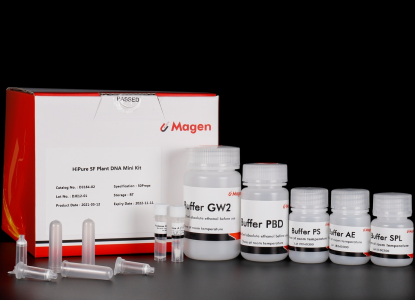Specifications
|
Features
|
Specifications
|
|
Main Functions
|
Isolation total DNA from100 mg simple plant
|
|
Applications
|
PCR, SSR, AFLP, RAPD and southern blot, etc.
|
|
Purification method
|
Mini spin column
|
|
Purification technology
|
Silica technology
|
|
Process method
|
Manual (centrifugation or vacuum)
|
|
Sample type
|
Economic plant samples
|
|
Sample amount
|
Fresh / frozen plant samples: ≤100mg
gDried plant / seed samples: ≤20mg
|
|
Elution volume
|
≥30μl
|
|
Time per run
|
30-50 minutes
|
|
Liquid carrying volume per column
|
800μl
|
|
Binding yield of column
|
100μg
|
Principle
Plantmaterial is first mechanically disrupted and then lysed by addition of lysis buffer and incubation. RNase A in the lysis buffer digests the RNA in the sample. After lysis, proteins and polysaccharides are salt-precipitated.Binding buffer and ethanol are added to the cleared lysate to promote binding of the DNA to the HiPure membrane. The sample is then applied to a column and then centrifuged. DNA binds to the membrane, while contaminants such as proteins and polysaccharides are efficiently removed by 2 wash steps. Pure DNA is eluted in a small volume of low-salt buffer or water.
Advantages
-
Safe - require nophenol or chloroform extraction
-
Fast - several samples can be extracted in 30 minutes by silica technology
-
High purity - high quality DNA, completely remove inhibitors
-
High yield - silica technology can achieve the highest yield
Kit Contents
|
Contents
|
D316402
|
D316403
|
|
Purification Times
|
50 Preps
|
250 Preps
|
RNase A
|
10 mg
|
50 mg
|
Protease Dissolve Buffer
|
1.8 ml
|
5 ml
|
|
Buffer SPL
|
30 ml
|
150 ml
|
|
Buffer PS
|
10 ml
|
50 ml
|
Buffer GW1
|
22 ml
|
110 ml
|
|
Buffer GW2*
|
12 ml
|
2 x 50 ml
|
Buffer AE
|
15 ml
|
60 ml
|
HiPure gDNA Mini Columns
|
50
|
2 x 125
|
2 ml Collection Tubes
|
50
|
2 x 125
|
Storage and Stability
RNase A should be stored at 2-8°C upon arrival. However, short-term storage (up to 24 weeks) at room temperature (15-25°C) does not affect its performance. The remaining kit components can be stored dry at room temperature (15-25°C) and are stable for at least 18 months under these conditions.
Experiment Data




